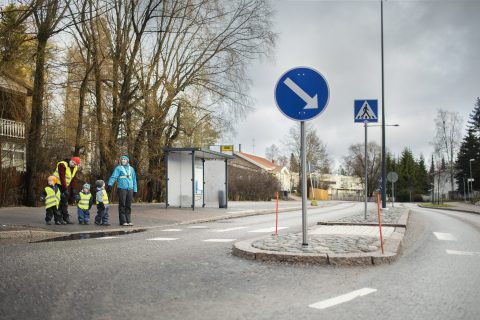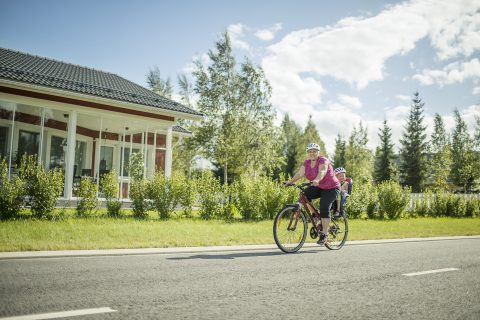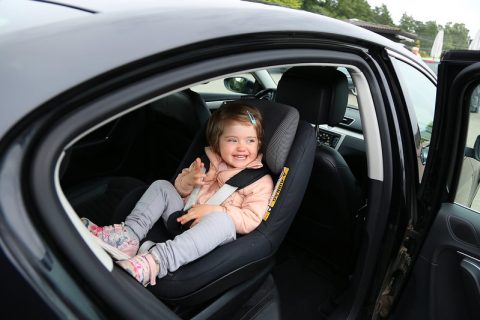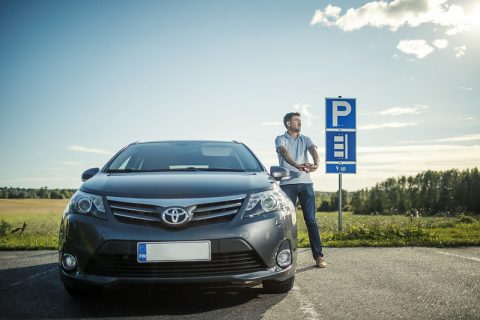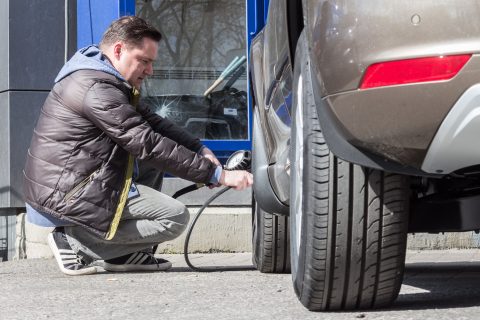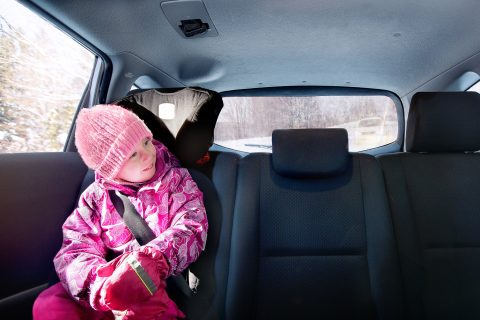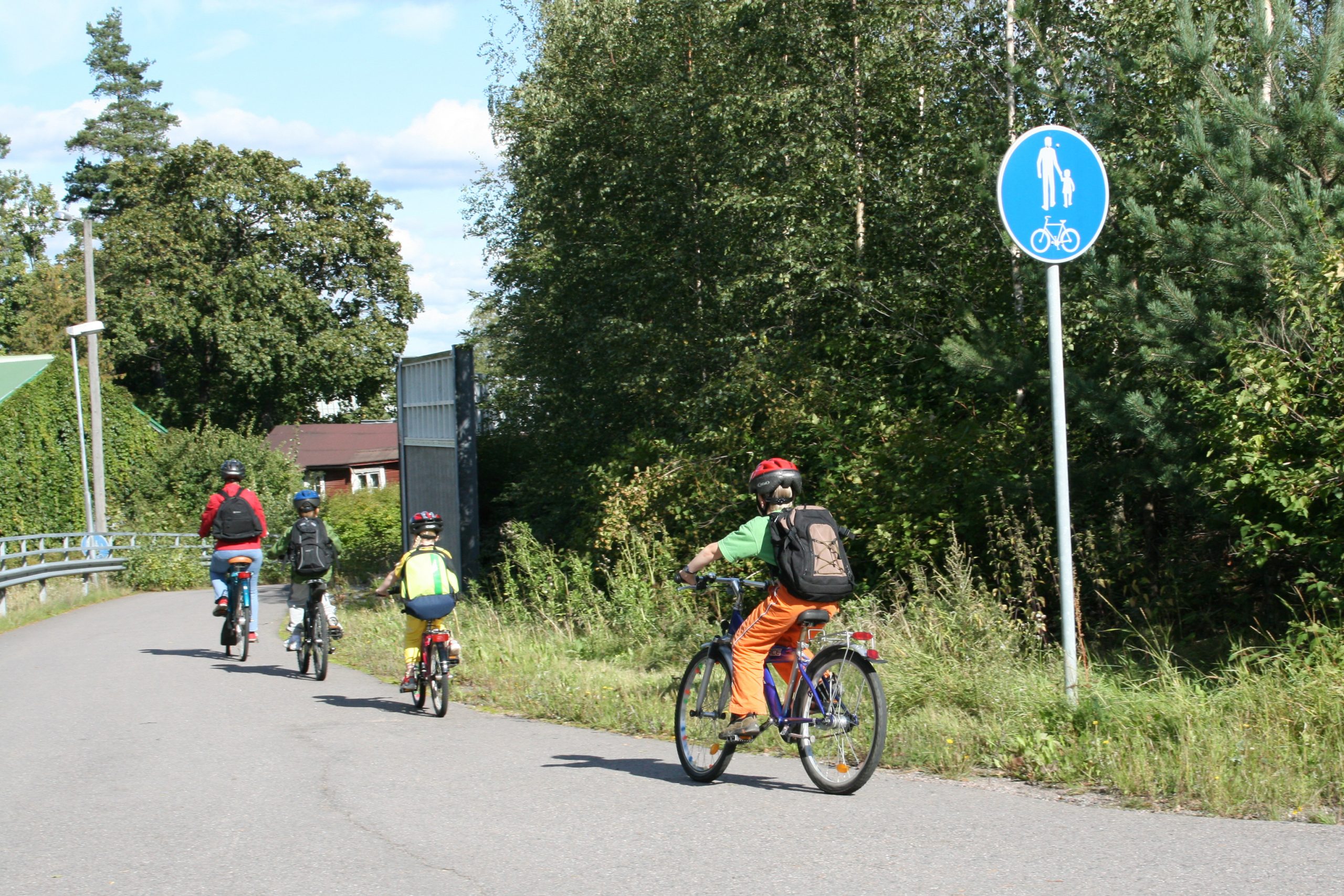
Practising a safe school journey
Practising together and talking about safety helps children make safe school journeys. On this page you can find tips for practising making safe school journeys with young children.
Children of pre-school age are already able to memorise and apply simple traffic rules. However, it is difficult for children to assess the speed and distance of vehicles. Children are also easily distracted by inconsequential things like dogs walking past.
They might not notice visual obstructions such as snow banks or bushes, and may forget to check whether anyone is approaching from behind such obstacles.
Children learn best in a real traffic environment. It is essential that adults lead by example to help the child develop a safe attitude. Practising safe behaviours helps the child navigate traffic safely.
Start practising the school journey in advance
It is advisable to practise the route several times with the child before they start school. Encourage the child to pay attention to various situations: “Someone might appear suddenly around that corner”, “On this corner, drivers can’t see you from behind the bush.”
Once the child has learned the basics, let them carry on independently under your supervision. By associating the adult’s advice with specific locations, the child learns the route and safe practices. Simple advice works best and is easy to remember: “Always stop before you cross a road, and take your time to check for approaching cars.”
It is also a good idea to video the school journey and watch it back together. Ask your child to explain things: “What do you see in this image?” “What do these images tell you about the traffic?” “Which spot requires special attention?” “What should you do in those spots?” Since young children are not able to accurately assess distance and speed, give them visual cues instead: “If the car has already passed that house, you must not cross.”
Consistent rules among parents
Children’s behaviour in traffic can be greatly influenced by their friends. You should observe how the child behaves in a group. It is also a good idea to discuss safety and rules with the parents of your child’s friends. Agree on a common set of safety rules. For example, all parents could agree to have their children wear reflective vests on the school journey. Also read about the walking school bus.
Phones should not be used on school journeys
Young children are not able to assess risks relating to phone use in traffic. Discuss phone use with your child and agree phone rules for the school journey. The best policy is to advise the child to stop in a safe place if they need to use their phone during the journey.
You should also avoid calling the child when you know that they are on the way to or from school. Lead by example: avoid using your phone when out on the roads.
School journeys on public transport or dedicated school transport should also be practised
You should also practise the school journey if your child travels by public transport or dedicated school transport. The child should not have to rush to the stop. Tell the child to wait for the transport at the stop on the side of the road. Remind them to be careful when getting on and off the transport. The child should remain seated during the journey and use a seatbelt, if available.
It is especially important to not attempt to cross the road in front of or behind the vehicle. A large vehicle blocks visibility, and other drivers might not spot the child. Tell your child not to cross the road until the vehicle has left the stop.
School runs by car
If possible, it is best for the child to travel to school independently. If you do drive them to school, let them walk the last kilometre or so. In this way, the child gains practice and experience in the calmer school zone.
Small children need a child seat in the car. The law requires that children under 135 cm are seated in a child car seat. The Finnish Road Safety Council recommends using a booster seat for children under 150 cm.
Practising continues throughout the school year
Ask the child regularly how their school journeys are going. Check that they remember what you practised with them. The school journey changes through the seasons. In winter, darkness and snow banks present additional challenges, and in summer the leaves of trees and bushes can affect visibility. Accompany the child regularly during the school year and revise traffic safety together.
Practical tips for practising safely navigating traffic:
On foot
- Discuss the safest route with the child – it is not necessarily the shortest.
- Discuss what types of visibility obstacles there are in different seasons (e.g. snow banks, vegetation) and how they affect the child’s ability to see other road users, and how they see the child.
- Remind the child to watch out for cars reversing out of parking spaces.
- Talk about traffic and regularly revise good practices with the child: “What should you do before crossing a road?”, “What should you wear when it is dark?”, “What should you remember before crossing this road?”
- Also talk about phone use in traffic and lead by example.
By bicycle
- The child should not start cycling to school until they have learned to make the journey safely on foot.
- The child should initially be accompanied by an adult when cycling.
- Stay close to the child.
- Make sure the child has an appropriately sized bicycle and helmet. Don’t forget to wear a helmet yourself!
- Regularly check the brakes, lights and reflectors of the child’s bicycle.
In public transport
- Practise taking the journey together.
- Explain why the child should always leave enough time to get to the stop and never rush.
- Discuss appropriate behaviour during the journey.
- Discuss why it is important to wait for the vehicle to leave the stop before crossing the road.
By car
- Children under 150 cm are safer in a booster seat.
- Help the child develop traffic safety skills by allowing them to walk the last part of the school journey – the presence of children also helps to calm down traffic in the school zone.
